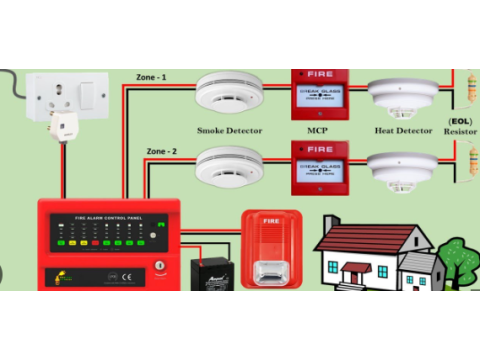FIRE ALARM SYSTEMS FOR PRIVATE HOMES
Installing a fire alarm system in a private home is not legally required, but it is a smart step toward enhancing fire safety. With the right setup, you can ensure early fire detection and take timely action to protect your home and loved ones.
CHOOSING MONITORING OPTIONS
Before installation, decide how the fire alarm system will be monitored:
Direct Link to Fire Services
- Generally unavailable for private residences and involves high setup and monthly fees.
Monitoring by a Security Company
- Sends fire alerts to a security provider for verification and notification of emergency services.
GSM-Based Alerts
- Sends notifications directly to the homeowner’s mobile device.
Standalone System
- Alerts occupants within the house but does not notify external parties.
SENSORS AND DEVICES FOR HOMES
Types of Sensors
- Smoke Detectors: Ideal for early fire detection in most residential settings.
- Heat Detectors: Used in areas with high dust or steam levels, such as kitchens.
- Multi-Sensor Units: Combine smoke and heat detection for improved accuracy.
Sensor Placement
- Install detectors on ceilings, ideally at the room's center for maximum coverage.
- Avoid placing them in corners or near walls.
Number of Sensors
- Install at least two sensors per room to improve reliability and reduce false alarms.
- Each sensor typically covers up to 70–80 square meters at ceiling heights up to 3.5 meters.
TYPES OF FIRE ALARM SYSTEMS
Wired Threshold Systems
- Low-cost hardware but requires significant wiring.
- Does not monitor sensor functionality.
Wired Addressable Systems
- More advanced, providing detailed sensor status and easier fault localization.
- Equipment is more expensive but requires less wiring.
Wireless Systems
- Easy to install and configure without extensive wiring.
- High-quality sensors can be costly and require periodic battery replacement.
INSTALLATION TIPS
Enhancing an Existing System
- Extend current wiring to add sensors in key areas like kitchens or utility rooms.
Installing a New System
- Choose a system type (wired or wireless) based on your home’s layout and needs.
- Use a GSM-enabled system for remote monitoring if desired.
Professional Installation
- While DIY installation is possible, hiring professionals ensures compliance with safety standards and optimizes system functionality.
CONCLUSION
A well-designed fire alarm system tailored to your home’s unique needs can provide cost-effective and reliable fire safety. While basic setups are sufficient for some, advanced systems with GSM modules or wireless configurations offer added convenience and security.
For premium fire alarm solutions, visit safsale.com—your trusted source for fire safety systems!

